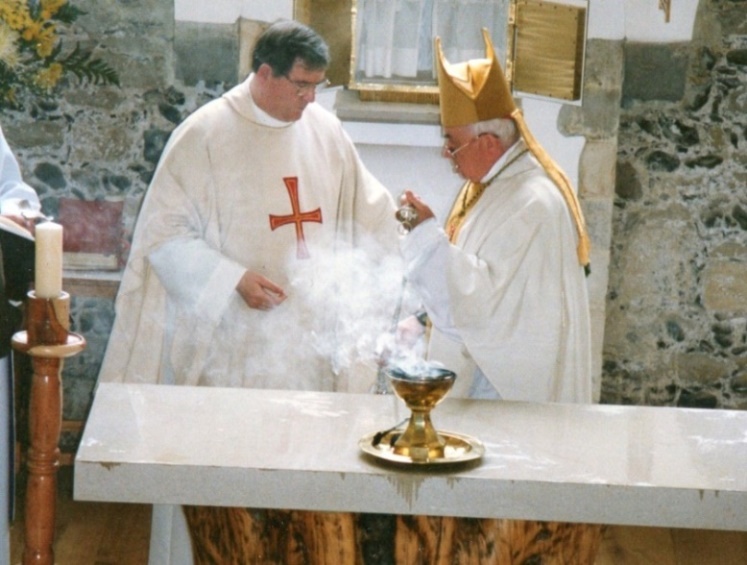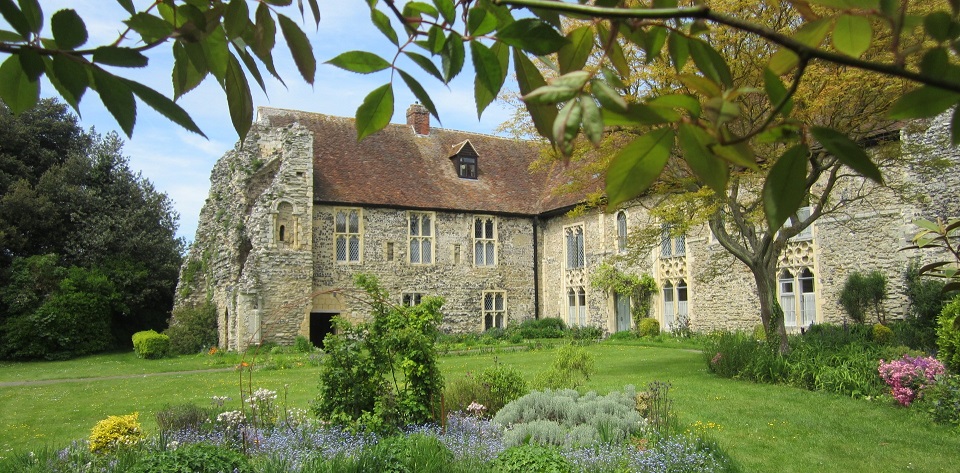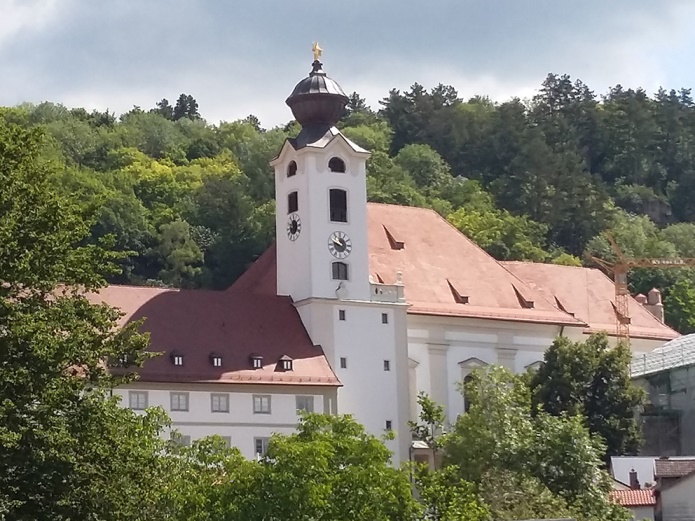1937 – Monastic Life Returns to Minster Abbey
At the dissolution of the monasteries in 1538, Minster Abbey fell to the Crown. It then became a private dwelling for nearly 400 years. In 1937 the property came up for sale and Dom Bede Winslow a monk of St. Augustine’s Abbey Ramsgate was excited by the possibility of of monastic life being re-established at the ancient Abbey. He contacted several English monasteries to ask if any were interested in purchasing the monastery, but as no community felt able to take up his suggestion, he contacted monasteries in Europe.

On the day that Dom Bede’s letter arrived at the abbey of St Walburga in Eichstatt, Bavaria, an officer of the Nazi SS requisitioned part of their buildings for the use of Hitler’s ‘storm troops’ . Abbess Benedicta saw the hand of providence in this ‘coincidence’ and was determined to view the property at Minster as soon as possible. She fell in love with Minster the moment she stepped through the gate, commenting that the centuries of prayer had left a great sense of peace. On her return to Eichstaat, Abbess Benedicta urged her community to buy the property at Minster. This was complicated by the fact that under the Nazi government, it was impossible to take money out of the country. Fortunately the community had recently made a foundation in America and the Sisters there were able to assist with fundraising. |

One of the nuns from Eichstatt, Sr Columbana, originally from Cornwall, was present on behalf of the Abbess on 25th March 1937, the feast of the Annunciation, when the deeds of Minster Abbey were handed over. With the help of the Abbess of East Bergholt in East Anglia, nine sisters from Eichstatt were able to obtain travel documents to come to Minster to begin the new monastic foundation. |

The new foundation was dedicated to Saint Mildred. The Sisters, six choir nuns and three lay Sisters, were very warmly welcomed, not only by the little Catholic parish and the monks of Ramsgate but by many in the village. They began to adapt the house for monastic use. In the early days the community went to the parish church for daily Mass, but from the first day, the Liturgy of the Hours was celebrated in the little monastery chapel. |

The lay Sisters began farming on a small scale, doing all the heavy work by hand, since they had no machinery – and certainly no money to buy any! Eventually they acquired Pippi, a sturdy pony, a plough and a cart, then a couple of cows and some hens. The Sisters tried to make some money by vestment-making and took in one or two guests. Other Sisters created beautiful calligraphy illustrations, an art learned at home at St. Walburga’s Abbey. |

It was a hard life with many daily worries. Abbess Benedicta tried to encourage the Sisters by her letters, assuring them that, “the Lord will help you, all the more as you rely on Him alone. It is important that you should have the same spirit as at St. Walburga’s. … Be simple and joyful. … All the people who visit our monastery are deeply impressed with the spirit of joy that shines on our faces. This is what you must aim at.” |
Wartime Internment
It was a great blow to the community when Mother Columbana died of consumption in 1938. The following year the Second World War broke out. As German citizens the Sisters had to be interned. The Sisters of Minster were given refuge with the Benedictine Sisters at Teignmouth in Devon. They had to remain strictly within the monastic enclosure, but they were able to live the monastic life throughout the War. Living alongside an English speaking community, they learned the language and also many gardening skills for a climate so different from their Bavarian home.
The Minster community experienced another great suffering when their Superior Mother Hiltraud died of cancer while the Sisters were at Teignmouth. Mother Emmanuel was then appointed as Superior and in November 1944, the community were able return to Minster. They found the house in a rundown state. It had been requisitioned for a period as an officers’ mess for RAF Manston. The Sisters worked enthusiastically to repair the property and build up the farm, and they joyfully embraced their monastic life at Minster Abbey.
By the end of the War, when contact with the mother-house was finally restored, the Abbess was seriously considering recalling the Sisters and selling Minster. Mother Emmanuel and the community, however, persuaded her to give them more time to make Minster viable. Among the reasons advanced for their continued stay were the growing ecumenical contacts of the community with the local Anglican churches. The Mother-house agreed, on condition that the Minster community should find its own income, since the Abbey of St. Walburga’s had no resources to spare. With great trust in God’s providence and a true pioneering spirit, the little community of nuns continued the life of prayer and work.

A New Roof for The Saxon Wing

In 1954 the community was also faced with a big challenge when it was discovered that the entire roof of the Saxon wing urgently needed replacing. The Sisters possessed a bank-balance of barely £30 to tackle a project costing many thousands. Mother Walburga appealed to the German Bishops Conference for help – with a reminder that St Edburga, Minster’s third Abbess, had assisted in the evangelisation of Germany in the 8th century! With their help and a grant from The American Pilgrims Trust, the roof repairs could be undertaken and at the same time new cells were built into the attic space. There was even enough money left over for the Sisters to buy a small second-hand tractor. This was to transform their work on the farm, which was the main source of income for the community.

The First Novices Join the Community
 In 1950, after completing her studies at Oxford, Yvonne Florescu applied to enter the community. She was the first person to enter the re-founded community and the Sisters were overjoyed at this sign of hope for their community. After her postulancy, as there was no formation program yet at Minster, she went to our Sisters in America to begin her Novitiate. After final profession she returned to the Minster Community as Sister John Baptist. In 1950, after completing her studies at Oxford, Yvonne Florescu applied to enter the community. She was the first person to enter the re-founded community and the Sisters were overjoyed at this sign of hope for their community. After her postulancy, as there was no formation program yet at Minster, she went to our Sisters in America to begin her Novitiate. After final profession she returned to the Minster Community as Sister John Baptist. |
 In 1953 Mother Walburga von Waldburg-Zeil of Eichstatt was appointed Prioress: she was to serve the community for thirty years. Under Mother Walburga the Noviciate was formally opened in 1954. The first person to enter the new Novitiate was Caroline Scott, later Sister Concordia. A few years later Sr. Ancilla Dent arrived and she was followed by a young Irish nurse, Sr. Patricia Lacey. In 1953 Mother Walburga von Waldburg-Zeil of Eichstatt was appointed Prioress: she was to serve the community for thirty years. Under Mother Walburga the Noviciate was formally opened in 1954. The first person to enter the new Novitiate was Caroline Scott, later Sister Concordia. A few years later Sr. Ancilla Dent arrived and she was followed by a young Irish nurse, Sr. Patricia Lacey. |



Years of Growth
While a few of the founding Sisters eventually returned to the Mother-house in Germany, the community also received new candidates seeking to live the monastic life of prayer, work and hospitality, each bringing her own gifts and skills. The new members came from Britain as well as abroad and this ‘internationality’ has remained one of the characteristics of the Community.


Hospitality is a key aspect of Benedictine monastic life. In the years following Vatican ll there was an increasing demand from many lay people to share in the life and prayer of the Minster community. To respond to this need in the Church, the Sisters developed their hospitality by extending the Gatehouse at the entrance of the Abbey to create further guest rooms.


The increasing number of guests meant that a larger Chapel was required. The Sisters had until this time used a room in the house as a Chapel, which could no longer accommodate the growing number of guests and retreatants.

Therefore in 1962 a prefabricated Chapel was built in the Abbey garden. It was dedicated to Our Lady of Peace.


This was an important development for the life and growth of the community as they implemented the principles of the liturgical reform and the renewal of the Church. They were to worship daily in this temporary Chapel alongside their guests and the local community for over 30 years.

There were changes on the farm too. Regulations were changing, and as the agricultural industry developed it became more difficult to make a profit from a small scale farm. The Sisters took the decision to change from dairy farming to raising goats and keeping a flock of sheep. Land was also made available to local farmers to lease for grazing of cattle and sheep.







In 1984 Mother Walburga after many years of loving service retired as Prioress. The community then elected Mother Concordia Scott. Already well known in the British Isles and abroad as a sculptress, Mother Concordia continued her art work while leading the community for the next fifteen years.


Disaster and a New Hope

During a thunderstorm, around midnight on 22nd August 1987, the community were awakened by the roaring sound of a fire which was engulfing the chapel. Guests had to be evacuated from the guest house and Mother Concordia rushed into the smoked filled chapel to rescue the Blessed Sacrament. The local fire brigade eventually got the fire under control, but the chapel was destroyed. It was the anniversary of the Dedication of the chapel!
Early next morning the community sang Lauds together in a makeshift chapel in the refectory. A local priest friend Fr. Jim Hurley came with vestments, liturgical books and all that was needed to celebrate Mass together. For the next 6 years the community celebrated the Liturgy alongside the guests and neighbours in this little chapel.
1987 was also special year of celebration for Minster Abbey as the community joyfully gave thanks to God for 50 years since the refounding of monastic life from St. Walburga’s in Eichstaat in 1937.




Two months after the fire, in October of that year, a hurricane swept the South East of England. The Abbey sustained some damage and, more seriously, a number of our ancient trees were destroyed. One of these however was later to find a new home as the altar in the new chapel.

After 6 years of fundraising and with the help of many generous friends, the new simple and beautiful Chapel of Our Lady and St. Andrew was dedicated on 4th June 1993. Here the community continues to gather for the celebration of Mass and the Divine Office. The Chapel houses relics of St Mildred and also a bronze statue of Our Lady, Seat of Wisdom,







1997 was the 1400th anniversary of St. Augustine’s mission to England. Minster Abbey welcomed pilgrims retracing the route of the missionaries from Rome, hosted ecumenical events and joined in the special celebrations taking place in St Augustine’s Abbey, Canterbury, and in Canterbury Cathedral. In the summer the Abbey provided the setting for a magnificent Son et Lumiere organized by the village community to celebrate the Jubilee.

Throughout the years each of the sisters continued to enrich the life of the community in so many ways. Many lived to a ripe old age and their spirit still lives on within the present community. At the same time the community continued to grow through the arrival of new members, each bringing their own particular gift to Minster Abbey.









Following her resignation as the 5th Prioress of Minster Abbey, the whole village community surprised Mother Concordia with a thanksgiving celebration to mark her retirement, and almost two hundred of our friends gathered in the gardens to sing “Amazing Grace” accompanied by a Scottish piper. This was a moving expression of their love and appreciation their beloved Sister Concordia!
Independance


On the Feast of All Saints in November 1996 the community was granted independence by the Mother-house in Eichstatt and Minster was raised to the status of a Conventual Priory. The Minster Community is deeply grateful for the rich heritage they have received from St. Walburga’s and pray for the continued blessing of St. Walburga and St. Mildred upon our communities.


On 1st January 1997 the Minster Abbey community was formally welcomed as a member of the Subiaco Congregation of the Order of Saint Benedict, an association of monasteries spanning five continents. We have been blessed with many enriching encounters.



